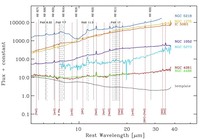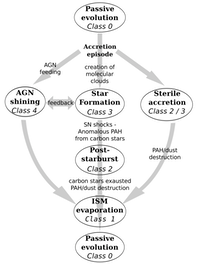Due to the low galaxy velocity dispersion, accretions and major mergers are considered the main drivers of the evolution of galaxies inhabiting low density environments, like groups. Ram-pressure stripping (Gunn & Gott 1972; Bekki 2009 and references therein) and galaxy ``harassment'' (see e.g. Moore et al. 1998) are the type of interactions that are taught to dominate within the core of dense clusters.
The combination of the above type of interactions, certainly evolving with time, is at the origin of the segregation of galaxy morphology with radius, well observed in clusters (Omler 1974; Dressler 1980). In galaxy groups, also in more dense associations like compact group of galaxies (CG), observations show a manifold of morphological properties (see e.g. Hickson et al. 1982). Some CGs are composed only of spiral members, others, characterized by a low level of activity of their members, are dominated by E/S0 galaxies (ETGs hereafter) with old stellar populations (see e.g. Coziol et al. 2000). If interpreted in a hierarchical scenario as an evolutionary sequence, CGs would evolve from a more active (SF, AGN etc.) phase, dominated by a population of late-type galaxies to a more relaxed and passive phase, inhabited by ETGs.
In this picture, potentially ``evolving'' CGs are interesting since they offer the possibility to investigate the multiplicity of mechanisms through which members galaxies and the group itself co-evolve. Zepf (1993) calculated that roughly 7% of the galaxies in CGs are in the process of merging. In this context, the paper presents the properties ofthe NGC~3933 system, the brighter spiral in the group, providing also evidence that its "core" is a compact group of galaxies. Ramella et al. (1994) have indeed shown that CGs are often hosted by more loose groups.
NGC 3934, the second brighter galaxy in the group,has been classified as a polar ring galaxy by Schweizer et al. (1983) and Whitmore et al. (1990). The main body of the galaxy shows a prominent dust-lane at an angle of about 80 degrees from the major axis in addition to a wide system of shells in the outer regions.
Polar ring galaxies (PRGs) and related objects are stable, systems frozen in a peculiar morphology, with matter rotating in two nearly perpendicular planes. Whitmore et al. (1990). Polar Ring Catalogue (PRC) lists more than 100 PRGs and candidate PRGs. Unfortunately, only a small fraction of them has been investigated. There is a general agreement that the formation of the polar rings is the result of some kind of ``secondary event'', like an external accretion/merger. Numerical simulations have shown that polar ring systems could be explained either by simple gas accretion (Reshetnikov & Sotnikova 1997), and Bournaud & Combes (2003:BC03) or by mergers of perpendicularly oriented disk galaxies (Bekki 1997; Bekki 1998; BC03).
However, in the PRC most objects do not show such a simple appearance with an edge-on central object and an edge-on polar ring. Rather they present more complex morphologies, in which they are frozen in a quasi-equilibrium state, avoiding complete relaxation towards a fully mixed symmetric system. These latter systems, called polar ring related objects, provide a unique chance to investigate the PRG formation scenarios since the initial components have not yet disappeared. If they are the results of mergers, it may still be possible to recognize the progenitors in the unrelaxed remnants, and attempt to reconstruct their formation events. NGC~3934 morphology fall in the category of polar ring related objects.
On the other side NGC~3934 possesses also a wide shell system. It is also widely believed that shell systems are produced by either by a major or a minor merger episode (Dupraz & Combes 1987, Weil & Hernquist 1993). NGC 3934 is a gas rich system: it was detected both in HI (Van Driel et al. 2002) and CO (Galletta et al. 1997) and it is a bright IRAS source. It may then represent a case of ``wet'' merging within compact galaxy groups.
Methods We imaged the NGC 3933 group with GALEX in FUV and NUV. We measured the recession velocity of NGC 213894 showing that its belongs to the group. We derived the SED from FUV to far-IR of the two brightest members of the group. We compared a grid of SPH chemo-photometric simulations with the SED and the integrated properties of NGC 3934 and of NGC 3933, to derive their possible formation/evolutionary scenarios.
Results The NGC 3933 group has 6 bright members: a core composed of 5 galaxies, with Hickson's compact groups characteristics, and a more distant member, PGC 37112. The global group velocity dispersion is relatively low (157+-44 km/s). The projected mass, from UV photometry is about 7x10^12 solar masses with a crossing time of 0.04 Hubble times, suggesting that, at least in the center the group is virialized. We do not find evidence that NGC 3934 is a polar ring galaxy, as suggested in the literature, but it is a disk galaxy with prominent dust-lane structure and a wide type II shell structure.
Conclusions NGC 3934 is a quite rare example of shell galaxy in a likely dense galaxy region. The comparison between physically motivated SPH simulations with multi-band integrated photometry suggests that NGC 3934 is a product of a major merger.
more details in
Bettoni, D., Galetta, G., Rampazzo R., Marino A., Mazzei, P., Buson L.M.
Nearby early-type galaxies with ionized gas. The UV emission from GALEX observations
2011, A&A, 534, A24





